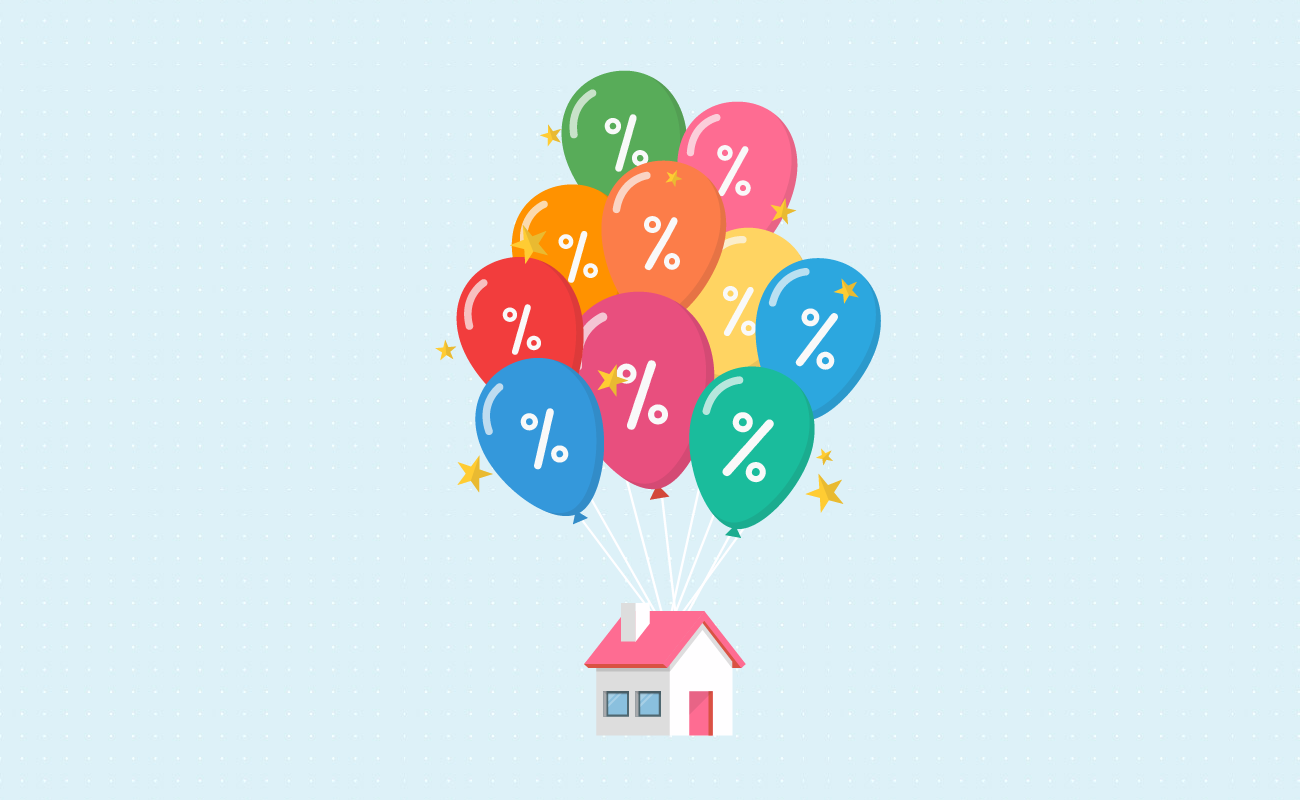Fixed Rates
30 yr
25 yr
20 yr
15 yr
10 yr
Compare Terms
Compare Rates
Real APR
Adjustable Rates
Qualification
Affordability
Renter Affordability
Rent vs Buy
Price per Square Foot
Jumbo
Home Sellers
 ARM APR Calculator
ARM APR CalculatorThis calculator helps homebuyers determine the effective interest rate (APR) of an adjustable rate mortgage (ARM) when including the upfront closing costs in the ARM mortgage calculations along with anticipated rate shifts. This calculator is for ARM loans & we also offer a similar APR calculator for fixed-rate mortagages.
Guide published by Jose Abuyuan on October 23, 2020

Buying a house is one of the largest expenses people make in lifetime. And when you decide on a mortgage, you have the choice to take the usual fixed-rate loan or the less popular adjustable-rate mortgage. Depending on your long-term plans, you might buy a temporary house and eventually move to a permanent one. This may be due to the demands of your career, the necessity of a better location, or simply the need for a larger house.
For people who intend to buy a starter home, they have the option to obtain an adjustable-rate mortgage (ARM), which typically comes with a low introductory interest rate. Choosing an ARM allows you to make affordable monthly principal and interest payments within a limited period, usually around 5, 7, or 10 years, before the rate adjusts.
Many borrowers who take ARMs eventually sell their house to move before the introductory period ends. But for those who intend to keep their ARM beyond the introductory period, their payments increase when market rates rise. In case you’re unable to sell your house once your rate adjusts, you must be ready to make higher monthly payments.
When you apply for an ARM, a lender typically quotes you an interest rate, such as 4 percent APR. However, this rate doesn’t show the true cost of borrowing money. Since the ARM rate eventually increases after the introductory period, it’s important to know your effective annual interest rate.
Our guide will discuss how to estimate an ARM’s effective annual interest rate (EAR), which is also referred to as the annual percentage yield. We will also define what annual percentage rate (APR) is and how different it is from the annual percentage yield (APY).
In short, the APY shows lenders precisely how much interest they will earn in a year, while it tells borrowers how much they need to spend. By knowing your APY, you can compare loan options before closing a deal with a lender.
How do banks estimate APY? Let’s first start with the basics. To calculate APY for savings accounts, banks use the following formula below:
APY = 100 [(1 + r/n)^n] – 1]
Where:
r = The stated annual interest rate, also called the nominal interest rate
n = The number of compounding periods each year
In this example, let’s say you deposited $1,000 into an account that pays 5 percent annually. By the end of the year, you will make $1,050. Here’s the APY calculation below.
APY = 100[(1 + 0.05/1)^1] – 1]
= 100[(1 + 0.05)^1] – 1]
= 100[(1.05)^1] – 1]
= 100[1.05] – 1]
= 100[0.05]
= 5%
Now, if the bank calculated interest every month, which has 12 compounding periods a year, you will have $1,051.16 by the end of the year. This means your APY is raised to 5.116 percent. See the calculation below.
APY = 100[(1 + 0.05/12)^12] – 1]
= 100[(1 + 0.004166666666666667)^12] – 1]
= 100[(1.004166666666666667)^12] – 1]
= 100[1.051161897881733] – 1]
= 100 [0.051161897881732976]
= 5.116189788173298
= 5.116%
The more your savings compounds, the more interest it earns. This is the advantage of compound interest. The increase may not seem significant at first, but given more time and a larger deposit, this difference becomes substantial.

Lending institutions usually promote APY to attract clients into making interest-bearing investments. Since APY is generally higher than APR, which yields more savings, it’s an appealing indicator for people. If a savings account only compounds interest once a year, APY and APR can be the same. But if a savings account compounds more than once annually, APY is generally higher than APR. The more frequent the compounding periods, the higher the APY.
Compound interest is the interest on a loan or investment that is calculated based on the original interest and the accumulated interest from previous periods. This is basically interest earned on interest. In the case of a loan, it occurs when interest is added on the principal balance, after which the interest rate is applied to the new principal, which results in a higher amount. The frequency of compounding periods is what further increases your loan amount.
When applied to savings accounts, compound interest helps grow savings the longer you keep money in the bank. But with mortgages and other consumer debt like credit cards, compound interest makes your payments more profitable for lenders. If you’re not careful, this can spiral into large debt. This is precisely what makes it difficult to pay off high-interest loans. And if you take an ARM, you must be ready to cover higher payments when your rate eventually increases.
If you have limited income, ARMs can be a very risky proposition, especially if you fail to cover interest payments along the way. The unpaid interest is added to your principal, which increases it rather than gradually reduce the amount you borrowed. When this happens, it can lead to negative amortization, where you might owe more on your mortgage than your home’s value.
If you’re still deciding whether to get a fixed-rate loan or an ARM, you can read about their pros and cons in our Fixed vs. ARM guide.

APR or annual percentage rate is the percent of interest charged on your loan’s principal. This rate determines the yearly cost of your loan, which accounts for your mortgage insurance and bank fees. APR also calculates the cost of your principal together with other fees that come with your mortgage. This includes origination fees, underwriting fees, private mortgage insurance (PMI), appraisal, discount points, and other closing costs. APR represents the amount you must pay over the course of a year.
On the other hand, APY or the annual percentage yield, also determines the amount you must pay over the course of a year. Likewise, it also includes mortgage insurance, bank fees, and other costs. Though both APR and APY are used to describe the annual interest rate charged on a mortgage, there’s a major difference between the two.
Unlike APR, APY factors in how often interest is applied to your balance. Thus, APY accounts for compound interest, while APR does not. It’s a more accurate measurement of how much your adjustable-rate mortgage will cost.
When you apply for an ARM, your lender assigns your APR. The APR for an adjustable-rate loan is reliant on many different variables. It factors in the current referenced index rate, the rate’s adjustment frequency, margin, and the maximum rate cap. These same variables also affect your APY.
Before you choose an ARM, learn more about these important variables below:
The index is the standard interest rate that reflects general market conditions. Lenders base mortgage rates on many types of indexes. Your ARM’s interest rate changes depending on the referenced index and your loan’s margin. The lender typically chooses which index to use for your loan. Once this is established, it cannot be changed after closing.
Here are commonly used indexes to determine mortgage rates:
The margin is the percentage added on top of your index rate, which is assigned by your lender. This is the fully indexed rate you must pay after the introductory period ends. Generally, lenders assign lower margins to borrowers with higher credit scores. When you’re perceived as a low-risk borrower, you are given a more favorable rate. Likewise, borrowers with lowers credit scores are given higher margins which result in higher monthly payments.
This determines how often your rate adjusts after the introductory period is through. Again, the more frequently your rate adjusts, the higher your interest costs throughout the term. ARMs usually adjust once a year after the introductory phase.
Rate caps function to limit how high your interest rate can increase throughout the entire term. Two lenders may offer the same introductory rate but give you different rate caps. Securing lower rate caps will help keep your payments from increasing to unaffordable amounts. A higher rate cap will make your payments more costly. Likewise, the lower your rate caps, the less you have to worry about unaffordable monthly payments. You should know your rate cap to estimate your maximum monthly principal and interest payment.
Apart from the variables above, you also need to look at expenses that are rolled into your mortgage. Your APR may also factor in the following costs:

As you can imagine, it’s more complicated to estimate an ARM’s annual percentage yield (APY) compared to a fixed-rate loan. Because the rate changes, your monthly payments also eventually increase. But to help estimate your ARM’s effective annual interest rate or APY, you can use our calculator on top. Let’s take the example below.
Let’s suppose you’re purchasing a home priced at $300,000. To bypass private mortgage insurance, you make a 20 percent down worth $60,000. You’re taking a 30-year 5/1 ARM with an introductory interest rate of 4 percent APR. The current index is 3.125 percent, and your lender assigns a margin of 2.5 percent. On top of this, you paid 1 percent for your origination fee and 1 percent for a discount point. Your maximum adjustment rate is 2.5 percent, while your rate adjusts every year (12 months) after the introductory period.
30-year 5/1 ARM
Home price: $300,000
Down payment: $600,000
Loan amount: $240,000
Beginning interest rate (APR): 4%
Current index: 3.125%
Margin: 2.5%
Origination fee: 1%
Discount points paid: 1%
Other included fees: $1,000
Maximum adjustment rate: 2.5%
No. of months before first rate adjustment: 60
No. of months between adjustments: 12
| Mortgage Details | Results |
|---|---|
| Total closing costs | $5,800.00 |
| Beginning monthly principal & interest payment | $1,145.80 |
| Fully indexed payment | $1,349.27 |
| Total monthly payments | $473,531.12 |
| Total interest | $233,531.12 |
| Effective adjustable-rate mortgage APR (APY) | 5.402% |
Based on the results, your ARM’s total closing costs will be $5,800, while your beginning monthly principal and interest payment (P&I) will be $1,145.80 for the first 5 years. But after the introductory period, your payment can increase as high as $1,349.27. This means you must have extra $203.47 every month to cover P&I payments when your rate increases. Finally, your total interest cost can be up to $233,531.12 for the entire term. From a beginning APR of 4 percent, your estimated effective annual APR will be 5.402 percent.
Now, what if you decided to take a longer ARM introductory term of 7 years? Given all the variables are the same, here’s how it will affect your mortgage payments.
30-year 7/1 ARM
Home price: $300,000
Down payment: $600,000
Loan amount: $240,000
Beginning interest rate (APR): 4%
Current index: 3.125%
Margin: 2.5%
Origination fee: 1%
Discount points paid: 1%
Other included fees: $1,000
Maximum adjustment rate: 2.5%
No. of months before first rate adjustment: 60
No. of months between adjustments: 12
| Mortgage Details | Results |
|---|---|
| Total closing costs | $5,800.00 |
| Beginning monthly principal & interest payment | $1,145.80 |
| Fully indexed payment | $1,335.53 |
| Total monthly payments | $464,854.76 |
| Total interest | $224,854.76 |
| Effective adjustable-rate mortgage APR (APY) | 5.236% |
According to the results, your closing cost will be $5,800 and your beginning P&I payment will $1,145.80, just like the first example. But after the introductory period, when the rate adjusts, your monthly P&I payment can be as high as $1,335.53. This means you must set aside an extra $189.73 to cover monthly payments when your rate increases. But compared to the first example, the fully index payment in the second example is slightly more affordable.
Furthermore, your total interest cost will be $224,854.76, which is lower by $8,688.24 than the first example’s total interest cost ($233,531.12). From a beginning APR of 4 percent, your estimated effective annual APR will be 5.236 percent. In this example, if you take the 7/1 ARM instead of the 5/1 ARM, you can save a couple thousand dollars more over the life of the loan. Thus, in this example, choosing an ARM with a longer introductory period can help lower your total interest expenses and reduce your ARM’s effective APR.

When you take an ARM, it’s important to know your loan’s effective annual rate, also known as the annual percentage yield (APY). APY is the total amount of interest you must pay on your mortgage for a year, which factors in the effects of compounding interest. This is a more accurate way to estimate the real cost of your mortgage over the entire term, rather than just referring to the ARM’s introductory rate.
On the other hand, APR or the annual percentage rate, also determines the annual interest cost of your loan. This includes origination fees and closing costs, as well as discount points. However, unlike APY, APR does not account for compounding interest, which is crucial in estimating total interest payments for an adjustable-rate loan. APY for a mortgage is also usually higher than the beginning APR.
Because ARM rates change after a several years, it’s important to account for rate increases that impact your monthly payments. For example, two lenders may give you a beginning rate of 4 percent. But upon estimating APY, you may find that one lender offers a lower APY than the other. Choosing a lower APY or effective annual interest rate can help maximize your savings. This allows you to compare and choose a more favorable deal.
Considering affordable interest-only payments on your loan? Before you take this option, learn more about it on our interest-only mortgage calculator.
Jose Abuyuan is a web content writer, fictionist, and digital artist hailing from Las Piñas City. He is a graduate of Communication and Media Studies at San Beda College Alabang, who took his internship in the weekly news magazine the Philippines Graphic. He has authored works professionally for over a decade.